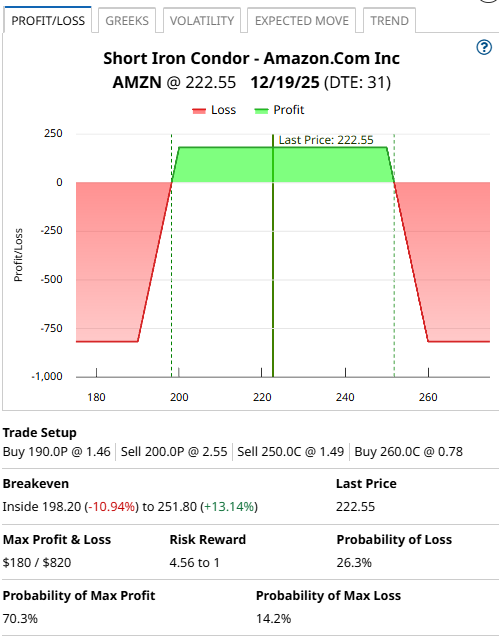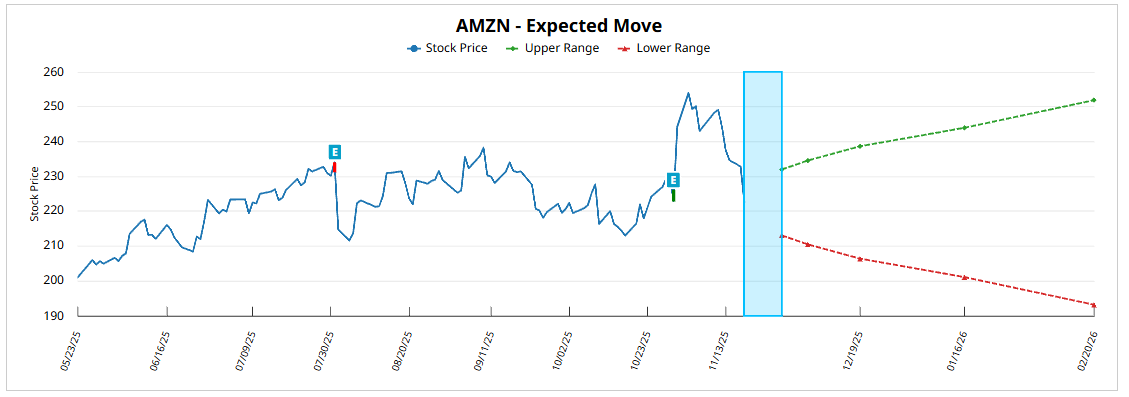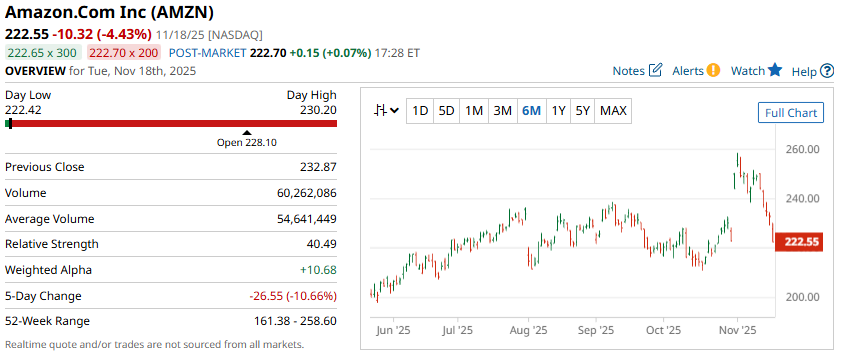Amazon (AMZN) is currently a compelling candidate for an iron condor strategy with the stock being stuck in between the 50 and 200-day moving averages.
Amazon stock is also showing high implied volatility at 36.72% compared to a twelve-month low of 22.95%.
This allows traders to collect more premium, increasing the potential return and providing a wider margin for error on both sides of the trade.
The company’s strong liquidity ensures tight bid-ask spreads, making it easier to enter and adjust positions.
With no immediate earnings catalysts, the likelihood of a sharp move in either direction is reduced, further supporting the use of this strategy.
AMZN IRON CONDOR
An iron condor aims to profit from a drop in implied volatility, with the stock staying within an expected range.
When implied volatility is high, the wider the expected range becomes.
The maximum profit for an iron condor is limited to the premium received while the maximum potential loss is also capped. To calculate the maximum loss, take the difference in the strike prices of the long and short options, and subtract the premium received.
Traders that think AMZN stock might stay in the current range over the next few weeks could look at an iron condor.
As a reminder, an iron condor is a combination of a bull put spread and a bear call spread.
The idea with the trade is to profit from time decay while expecting that the stock will not move too much in either direction.
First, we take the bull put spread. Using the December 19 expiry, we could sell the $200 put and buy the $190 put and then
the bear call spread, which could be placed by selling the $250 call and buying the $260 call.
In total, the iron condor will generate around $1.80 per contract or $180 of premium.
The profit zone ranges between $198.20 and $251.80. This can be calculated by taking the short strikes and adding or subtracting the premium received.
As both spreads are $10 wide, the maximum risk in the trade is 10 – 1.80 x 100 = $820.
Therefore, if we take the premium ($180) divided by the maximum risk ($820), this iron condor trade has the potential to return 13.14%.

If price action stabilizes, then iron condors will work well. However, if AMZN stock makes a bigger than expected move, the trade will suffer losses.
The expected move for Amazon stock over the next 31 days is between 206.44 and 238.66, which is less than the profit range of this Condor.


COMPANY DETAILS
The Barchart Technical Opinion rating is a 48% Buy with a Weakening short term outlook on maintaining the current direction.
AMZN rates as a Strong Buy according to 51 analysts with 6 Moderate Buy ratings.

Amazon.com is one of the largest e-commerce providers, with sprawling operations spreading across the globe.
Its online retail business revolves around the Prime program well-supported by the company's massive distribution network.
Further, the Whole Foods Market acquisition helped Amazon establish footprint in physical grocery supermarket space.
Amazon also enjoys dominant position in the cloud-computing market, particularly in the Infrastructure as a Service space, thanks to Amazon Web Services, which is one of its high-margin generating businesses.
Amazon has also become a household name with its Alexa powered Echo devices.
Artificial Intelligence backed Alexa is helping the company sell products and services.
The company reports revenue under three broad heads'North America, International and AWS, respectively. Amazon targets three categories of customers - consumers, sellers and website developers.
Conclusion And Risk Management
One way to set a stop loss for an iron condor is based on the premium received. In this case, we received $180, so we could set a stop loss equal to the premium received, or a loss of around $180.
Another way to manage the trade is to set a point on the chart where the trade will be adjusted or closed. That could be around $210 on the downside and $240 on the upside.
Please remember that options are risky, and investors can lose 100% of their investment.
This article is for education purposes only and not a trade recommendation. Remember to always do your own due diligence and consult your financial advisor before making any investment decisions.
On the date of publication, Gavin McMaster did not have (either directly or indirectly) positions in any of the securities mentioned in this article. All information and data in this article is solely for informational purposes. For more information please view the Barchart Disclosure Policy here.
More news from Barchart
- High-Probability AMZN Iron Condor with 13% Return Potential
- This Consumer Stock is Already in a Bear Market. Smart Money Sees 20% More Downside Ahead.
- Data Science Points to Upside for Citigroup (C) Stock Despite the ‘Insurance’ Bet
- Domino's Pizza Stock is Undervalued Here - Shorting One-Month Put Options Yields 1.67%





